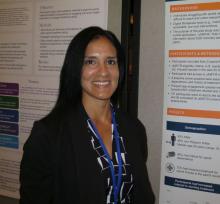SAN DIEGO – Individuals with opioid use disorder generally embraced the idea of using a novel mobile application to learn about recovery options and medication-assisted treatment, according to results from a pilot study.
“We found that, after participants engaged with our mobile app, their interest for recovery and attitudes about recovery improved,” lead study author Patricia Cavazos-Rehg, PhD, of the department of psychiatry at Washington University in St. Louis, said in an interview at the annual meeting of the College on Problems of Drug Dependence. “We were not expecting results to be so positive, and these findings are very promising because they suggest that individuals may not have interest in or be reluctant to engage in treatment. But we can engage them with a tool that will get them interested and move them toward treatment recovery.”
Dr. Cavazos-Rehg and her associates set out to examine the effectiveness of a mobile application called “uMAT-R,” which includes evidence-based health information about opioid use disorder recovery and medication-assisted treatment (MAT). The app is being develop in partnership with iTether, an Arizona-based mobile health software company. Material for the user is derived from the Substance Abuse and Mental Health Services Administration’s online handbook, “Decisions in Recovery: Treatment for Opioid Disorders,” and is divided into consumer-friendly content modules that provide information on MAT, including costs, latest research findings, and potential side effects.
For the study, researchers recruited 161 individuals 18 years of age and older from three opioid-focused groups on Reddit to pilot the use of uMAT-R. To be eligible, they had to be a U.S. resident, be fluent in English, have misused opioids in the past 30 days, and not currently be using medication-assisted treatment. Participants had access to the app for 1 month, and the researchers administered a baseline questionnaire that assessed demographics, opioid dependence, and history of treatment. They also administered pre- and postapplication engagement questionnaires that assessed attitudes toward MAT, treatment interest, and usefulness of the app.
Of the 161 invited participants, 44 downloaded the app, and 26 completed all content modules and all pre- and postapp assessments. The median age of the 26 participants was 28 years; 65% were male, and 88% were non-Hispanic white. Nearly all (96%) met criteria for opioid dependence, and 12% had received treatment for opioid misuse in the past 6 months. Dr. Cavazos-Rehg and her associates found that only 32% expressed interest in starting treatment for their opioid use disorder before using the app, compared with 48% after using the app, a difference that reached statistical significance (P = 0.046). Feedback from participants was mostly positive. For example, 92% agreed that the app includes useful tips on how to make life better; 88% would consult the app if they had to make a decision about their recovery; 88% believed the app has a positive outlook; 84% said the app helped them have a better understanding of options for recovery, and 84% said they learned something new from the app.
In addition, scores on the MAT attitudes scale rose from a mean of 3.3 to a mean of 3.5 (P = 0.044).
“,” Dr. Cavazos-Rehg said. “We want to develop a mobile app that will teach individuals who have opioid use disorder about their recovery options so that we can nudge them towards considering recovery, and our findings indicate some success with this goal.”
Next, she and her associates plan to pair use of the app with traditional in-person care among pregnant women with opioid use disorders. “Even if people are engaged in treatment, they still only see a therapist or a clinician once or twice a week,” she said. “We want to be able to use a mobile health treatment to support their needs while they are outside of treatment.”
The study was funded by a grant from the National Institutes of Health. Dr. Cavazos-Rehg reported having no financial disclosures.

